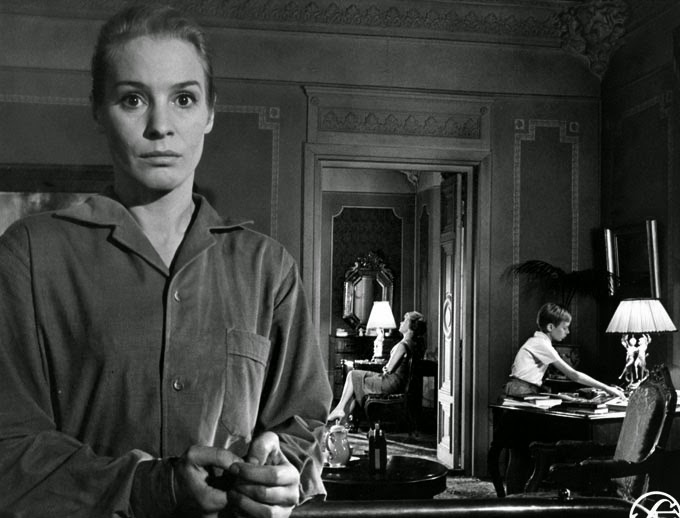The other recent double feature I attended at WHC was the pairing of Antonioni's Il Grido (1957), The Outcry, and Bergman's Tystnaden (1963), The Silence, in honor of the directors' deaths at the end of July within hours of each other. I have to say that other pairings could have given the films more to say to each other. It seems the films were paired only in so far as they both manifested how relentlessly each director pursued his particular aesthetic. The films had little in common, though I suppose "silence" and "outcry," as titles and situations, do have a certain resonance.
Watching them, it became clearer to me (not that I didn't know it already) that Antonioni's aesthetic is the one I prefer. The power of his images is comprised entirely of compositional elements. Nothing is shown that isn't in a sense realism, but everything is shown in an artistically achieved way. I would almost say "in a contrived manner" -- except I'm afraid "contrived" would be taken as disparaging. It's not intended that way. What inspires my fascinated viewing is that each shot is "set up," the way the perspective of a painting is "contrived." In fact, I think that what Antonioni gives to film, that has disappeared from most work in cinema, is the sense of each shot as composed the way a painting is composed. There are moments in the film that are nothing -- as story, action, symbolism -- but which look like meditations on gray tones, on figures against a ground, on views between exterior and interior, on the use and meaning of perspective. It seems to me that only an audience that has spent some time "reading" representational paintings can get the most out of an Antonioni film of this period.
The story itself was more "heart-felt" than the typical Antonioni movie, mostly because of Steve Cochran's very vulnerable performance as the lead character, Aldo. But to place the meaning of the film under those clichés of "alienation" and "lack of communication" strikes me as a bit ironic. In other words, those "big words that make us so unhappy" (to borrow Stephen's phrase) are also a failure to communicate. What I was struck by more, because I commented on Robinson's Housekeeping recently, was how Aldo's story is also the story of a drifter -- in this case expelled into movement by his mate's refusal to marry him, by her preference for someone else -- who can find no settled life. Which is to say, that it shows how loss can make someone a loser, not simply in the sense of "failure," but in the sense of one who loses things -- like affective ties, like a purpose or a goal, even as his old town is eventually given a purpose: to be bought and knocked down for airplane manufacture.
The Silence presents, I suppose, another loser in that sense, though we watch the film with little sense of what constituted the ailing elder sister's existence before she arrived at the hotel with Anna, her younger sister, and Anna's son Johan, except that the sisters were "close," probably even lovers. That Ester's in a bad way is clear enough, that she's a translator is made much of, that she is a lesbian is established and then given a forceful statement at the film's close. The contrived nature of Bergman's world, though, is different from Antonioni's and I will use the term disparagingly. The fact of the sisters staying in a town where they can't speak the language is odd, one of those "inability to communicate" situations made literal -- achieving comic effects at moments having to do with the old, loose and baggy concierge who eventually comes to seem a ministering angel to Ester -- but feeling enigmatic for the sake of enigma. The young boy, through whom a good part of the action is focalized, put me in mind of Alexander in Fanny and Alexander, though his adventures are more a kind of comic relief from the tensions between the sisters rather than an odyssey of discovery as in that later film.
As to the images themselves: I generally watch Sven Nykvist's cinematography with rapt enthusiasm, but this film is so claustrophobic -- despite the long halls of the elegant hotel where the boy wanders -- so caught up in a language of facial closeups and closeups of glasses, pillows, headboards -- that it becomes oppressive (deliberately). Hard to watch after all those long, low flat horizons in Il Grido. The image from The Silence that stays with me is Ester leaning, exhausted and short of breath, on the door of the room where her sister has shacked up with a male lover from the street, as the troop of dwarves performing at the hotel parade by in costume. The last two -- a harlequin with a drum and a black-draped, white-faced death figure -- seem to stay longest on screen as they pass, hanging for a moment as, it seems, the only ones that register with Ester. It's a comic moment, but also cruel and so memorable. Rare enough are the moments in the film where I can say an image gives pleasure, rather than expressing the oppression of desire, the uselessness of language, the need for physical contact. The rest is silence.


No comments:
Post a Comment